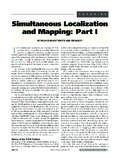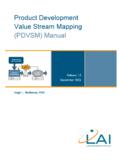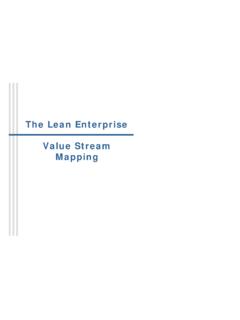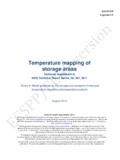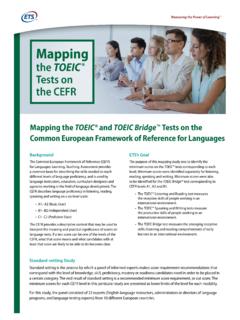Transcription of Mapping the HR Value Proposition - AMERIN
1 Mapping the HR Value Proposition A systemic approach that makes visible and credible the Value -added contribution of HR professionals In their must-read book The HR Value Proposition , (see the Further Reading section for details), Professors Dave Ulrich and Wayne Brockbank outline a practical approach for HR professionals to add business Value . They state HR professionals add Value when their work helps someone reach their goals. It is not the design of a program or declaration of policy that matters most, but what recipients gain from these actions. In a world of increasingly scarce resources, activities that fail to add Value are not worth HR Value Proposition means that HR practices, departments, and professionals produce positive outcomes for key stakeholders employees, line managers, customers, and investors. Unfortunately, in some organisations HR is still not seen as an occupational group that delivers Value to key stakeholders.
2 In an article from a Melbourne newspaper, The Age, tilted Getting down and dirty with HR , (August 31, 2005), critics view HR as the handmaiden of management, the only one without smarts to work as a strategic most organisations HR is seen as a cost Channel Nine boss Sam Chisholm recently got rid of his HR director and deputy (to cut costs), he ordered senior staff to take a crash course in how to do human resources. Ulrich and Brockbank point out that if HR professionals want to hold onto their jobs and increase their influence, they must focus less on what they do their processes and systems and more on the Value they can deliver to the business. They must ensure they have a direct line of sight with their key stakeholders. HR jobs that focus on processes and systems are already becoming redundant. Much of the transactional work of HR such as payroll, employee policies, training administration, and so on, is being automated, centralized or outsourced.
3 The Commonwealth Bank of Australia (CBA) is set to sign a landmark contract with Indian computing company Infosys. CBA has chosen Infosys to take over responsibility for maintaining and enhancing the bank s human resources and payroll applications. (The Australian Financial Review, CBA set to sign up Infosys , September 6, 2005) The new economy means new thinking, new models and new HR competencies and deliverables In a time when HR personnel are being made redundant it s ironic that their service deliverables are becoming central to business performance improvement. As societies shift from the old industrial era to new service / knowledge economies the more valuable HR deliverables will become in creating a competitive advantage for organisations. Consider for instance the market values of new economy companies. They are largely determined by intangibles, and managing them is critical because of their impact on shareholder Value .
4 Such things as leadership, governance, R&D, innovation, reputation, 1brand strength, tacit knowledge, plant flexibility, speed and quality of service, customer and employee loyalty, and informal processes and trusted networks are essential factors when it comes to the future growth expectations of investors. In the service / knowledge economy intangibles are treated as wealth-creating assets that if managed effectively, produce increasing returns. Shares in blood plasma group CSL rocketed more than 6% on Friday after successful vaccine trials for treating cervical cancer. CSL CEO, Dr Brian McNamee, said The success of this trial recognises the Value of our R&D s a triumph for Australian science . (The Australian Financial Review, CSL soars on success of cancer vaccine , October 8, 2005) Being able to create increasing returns from intangibles presents tremendous opportunities for HR professionals because the only way intangibles gain Value is through people.
5 The benefits intangible investments yield are the only means companies can use to escape intensifying competitive pressures. Baruch Lev, Harvard Business Review, June 2004. This situation creates a compelling argument that to drive profitable growth from intangibles, this asset class must be systemically managed by HR. But to seize this opportunity HR departments and professionals must fundamentally transform their roles. Ulrich and Brockbank argue too that HR s role must be transformed in order to deliver Value to customers, shareholders, managers and employees. They argue that this transformation requires integrating the various HR practices and focusing them jointly on Value -added agendas such as intangibles, customer connection, organisation capabilities and individual abilities. They state that such a transformation has six implications for HR, namely:- 1. HR work does not begin with HR it begins with the business.
6 HR needs to be able to show how their activities create Value for key stakeholders 2. HR must have a direct line of sight to the market place that is, to the customers who buy products and services and to shareholders who provide capital. 3. HR must be framed as a source of competitive advantage it must be able to demonstrate that it creates human abilities and organisational capabilities that are substantially better than its competitors 4. HR professionals must align practices with the requirements of internal and external stakeholders they must align their practices with accurate perceptions of the ultimate receivers of the organisation s Value and collaborate with others in the organisation 5. HR professionals must acquire the personal knowledge and skills necessary to link HR activity to stakeholder Value this includes articulating how HR adds Value to key players within an organisation 6. HR professionals need to be able to spell out how they provide a unique and powerful perspective of the linkages between employee commitment, customer attitudes and investor returns they need to be able to describe the aspects of the business environment that go beyond what other disciplines bring to the business.
7 2 Systemic HR Mental Models We totally agree with these HR transformation implications. However, from our experience, we believe that to successfully undertake this transformation there is a 7th implication for HR. We believe HR needs to frame a new mental model that will make others take notice and listen to the profound and sustainable benefits HR brings to organisations in the new economy. Such a mental model must form the strategic framework that provides HR professionals with the evidence that HR is truly adding Value to key stakeholders. To develop a HR mental model involves systemically Mapping the HR Value Proposition defined by Ulrich and Brockbank so it makes visible and credible to stakeholders and business colleagues the Value -added contribution of HR professionals. Once developed, a systemic HR mental model will provide the strategic framework that enables HR professionals to make significant and tangible contributions to business performance.
8 For instance, HR professionals will be able to use these models to economically justify their initiatives, advise where the business is at risk, highlight opportunities to continually improve performance, and most importantly, show how they add stakeholder Value . To create this new HR mental model requires HR professionals to think systemically about their organisation operating within its environment and to be competent in the use state-of-the-art systemic tools and concepts designed to add stakeholder Value . Thinking systemically enables HR professionals to see their organisation from a different frame, which in turn enables them to act on strategically important business data that they or other managers may have previously overlooked. Not having a systemic frame creates blind spots about how an organisation can, over time, adapt to and influence its environment. The business world is full of organisational shipwrecks when thinking is predominantly closed/non-systemic and systematic.
9 Systemic HR Competencies and Deliverables From their research into HR competencies that make a difference to stakeholder Value , Ulrich and Brockbank found that strategic contribution is significantly important in HR s efforts of meeting stakeholder expectations and influencing business performance. Their study, undertaken at the University of Michigan s Business School, is the longest and largest study of the competencies of HR professionals. Their project commenced in 1987 and they have evaluated every mainstream HR competency in companies representing a wide range of industries and sizes from Europe, Asia, Latin America and North America. Ulrich and Brockbank identified 17 essential HR competencies that make a difference in adding stakeholder Value . 3 Some familiar, and possibly not so familiar competencies include: Design and deliver a culture-based HR strategy that links internal culture to the requirements of external customers and the business strategy, and focuses HR activities to create and sustain the required culture Plan and implement large-scale interventions that make change happen quickly Contribute to business decision making by critiquing existing strategy, by having a personal vision for the future of the business, and by raising the standard of strategic thinking in the management team Facilitate the dissemination of customer information throughout the firm to create organisational unity and responsiveness Design organisational structures and work processes Design and deliver staffing cycles that include hiring, promoting, transferring, retaining.
10 And firing Design and deliver developmental agendas that integrate individual and organisational learning and development Measure results at each stage of the HR Value Proposition Have knowledge of each component of the business Value chain and its integration that makes the Value chain whole greater than the sum of its parts Have knowledge of how the company creates Value through portfolio management and meeting the requirements of the competitive market place Their study also revealed that what HR professionals do best (personal credibility doing what they say they ll do, interpersonal skills, communication skills) has a moderate influence on business performance. Meanwhile, what HR professionals do only moderately well (strategic contribution) has almost twice the influence on the business where it occurs. Statistical analysis identified four subsets of strategic contribution: culture management, fast change, strategic decision making, and market-driven connectivity.


